Medical Malpractice Lawyer Resume Examples

Jul 18, 2024
|
12 min read
Nailing your medical malpractice lawyer resume: build your professional profile and win over hiring managers without malpractice! Learn how to highlight your skills and experience effectively to stand out in the legal field.
Rated by 348 people
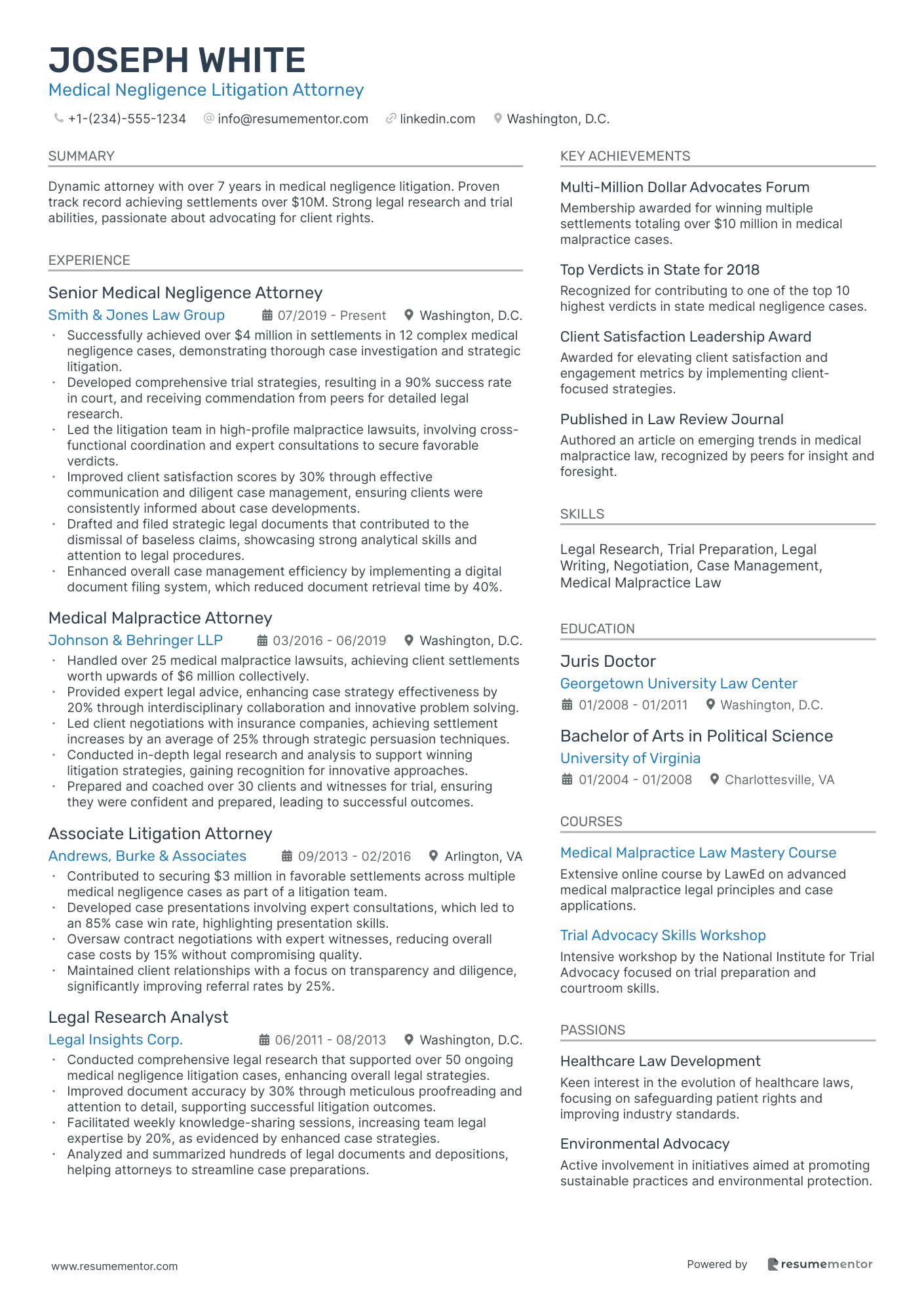
Medical Negligence Litigation Attorney
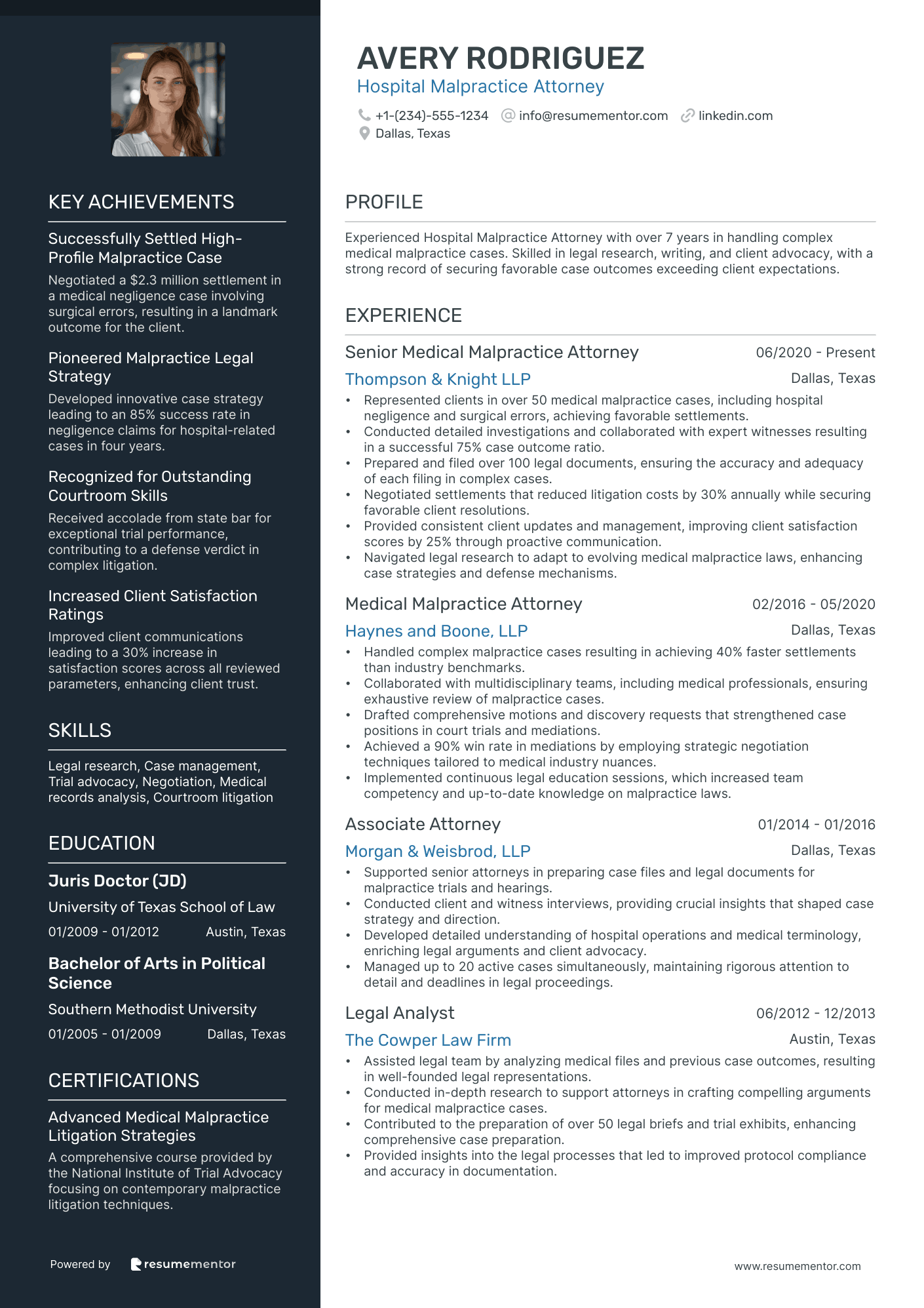
Hospital Malpractice Attorney
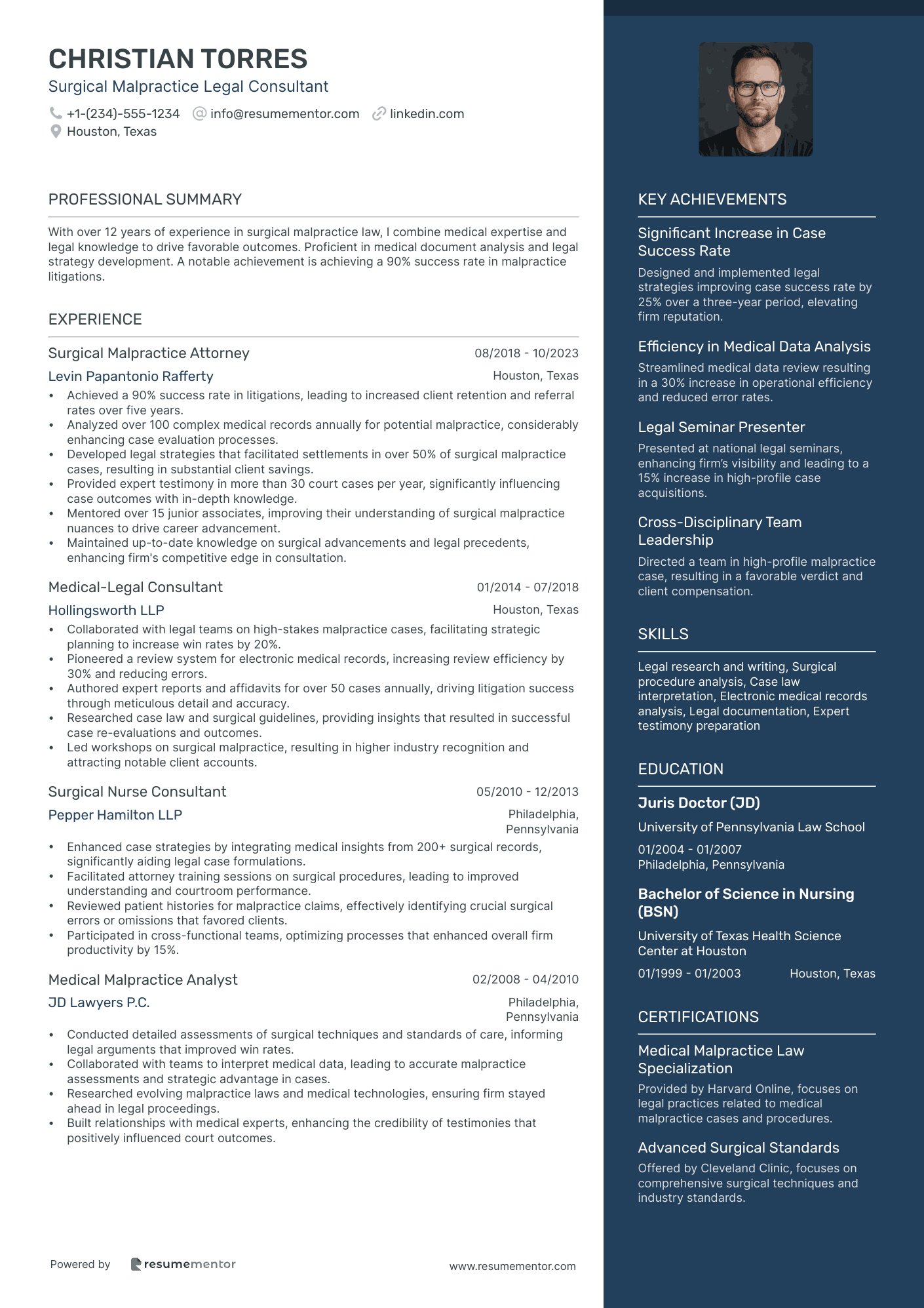
Surgical Malpractice Legal Consultant
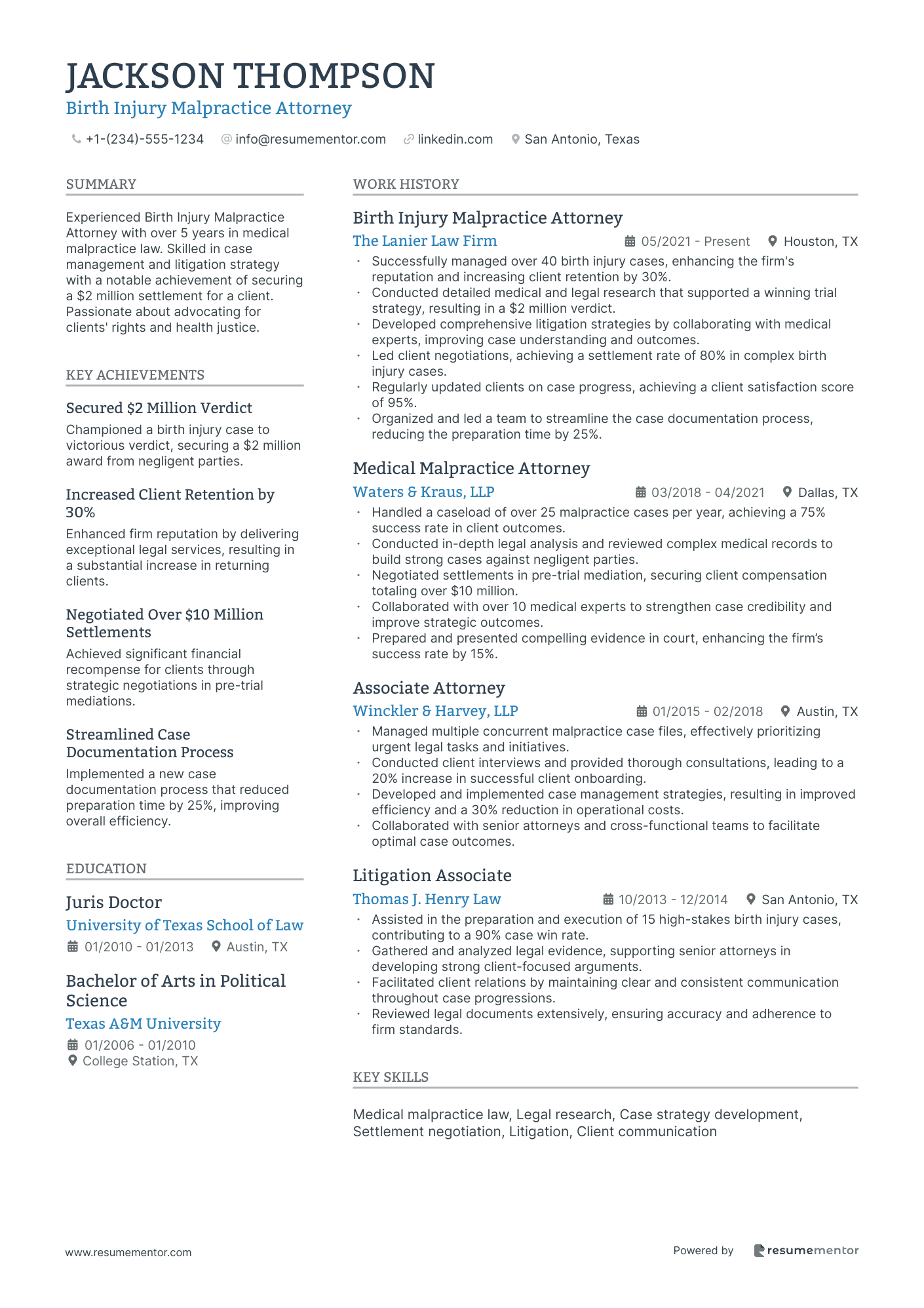
Birth Injury Malpractice Attorney

Pharmaceutical Negligence Lawyer
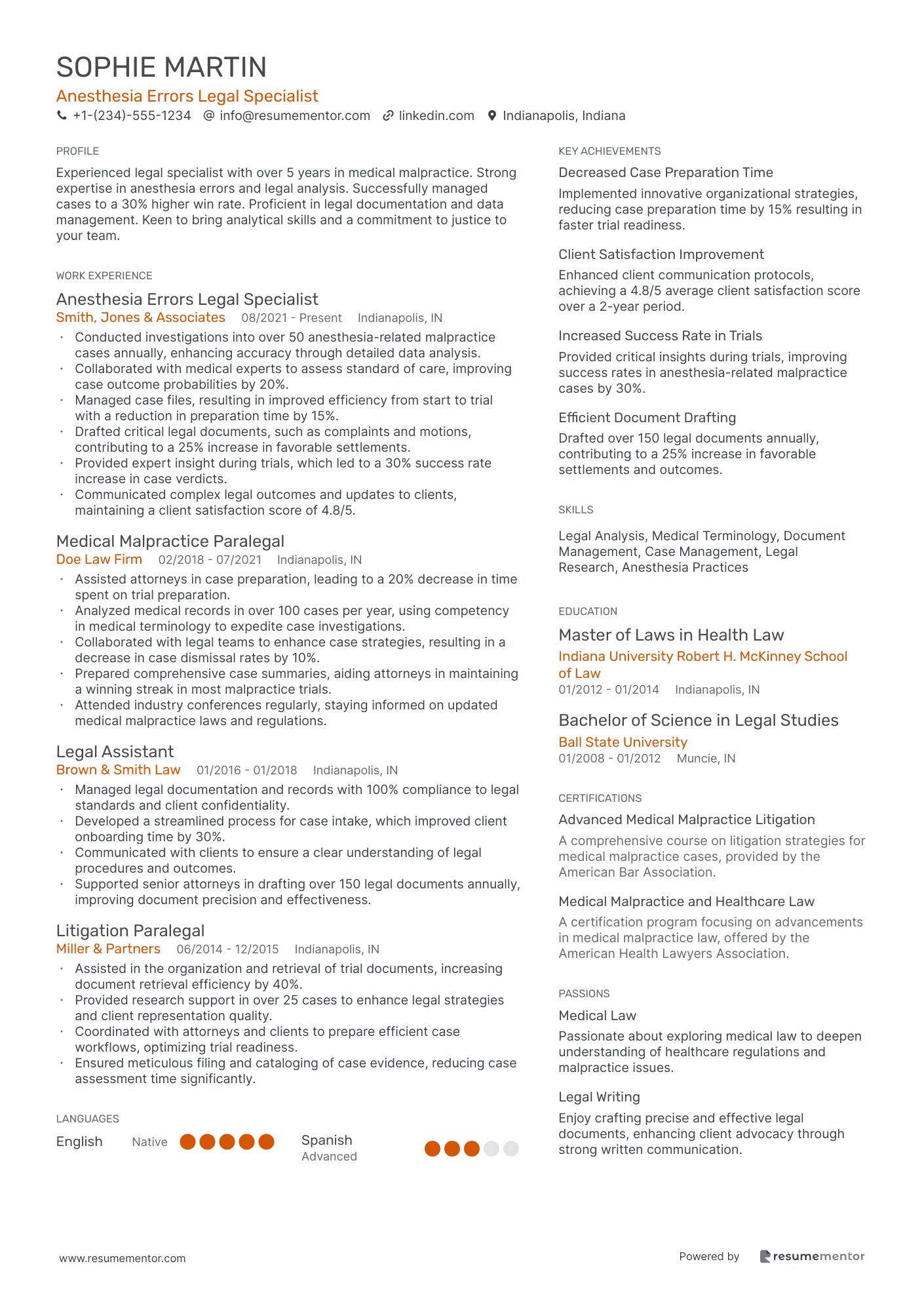
Anesthesia Errors Legal Specialist
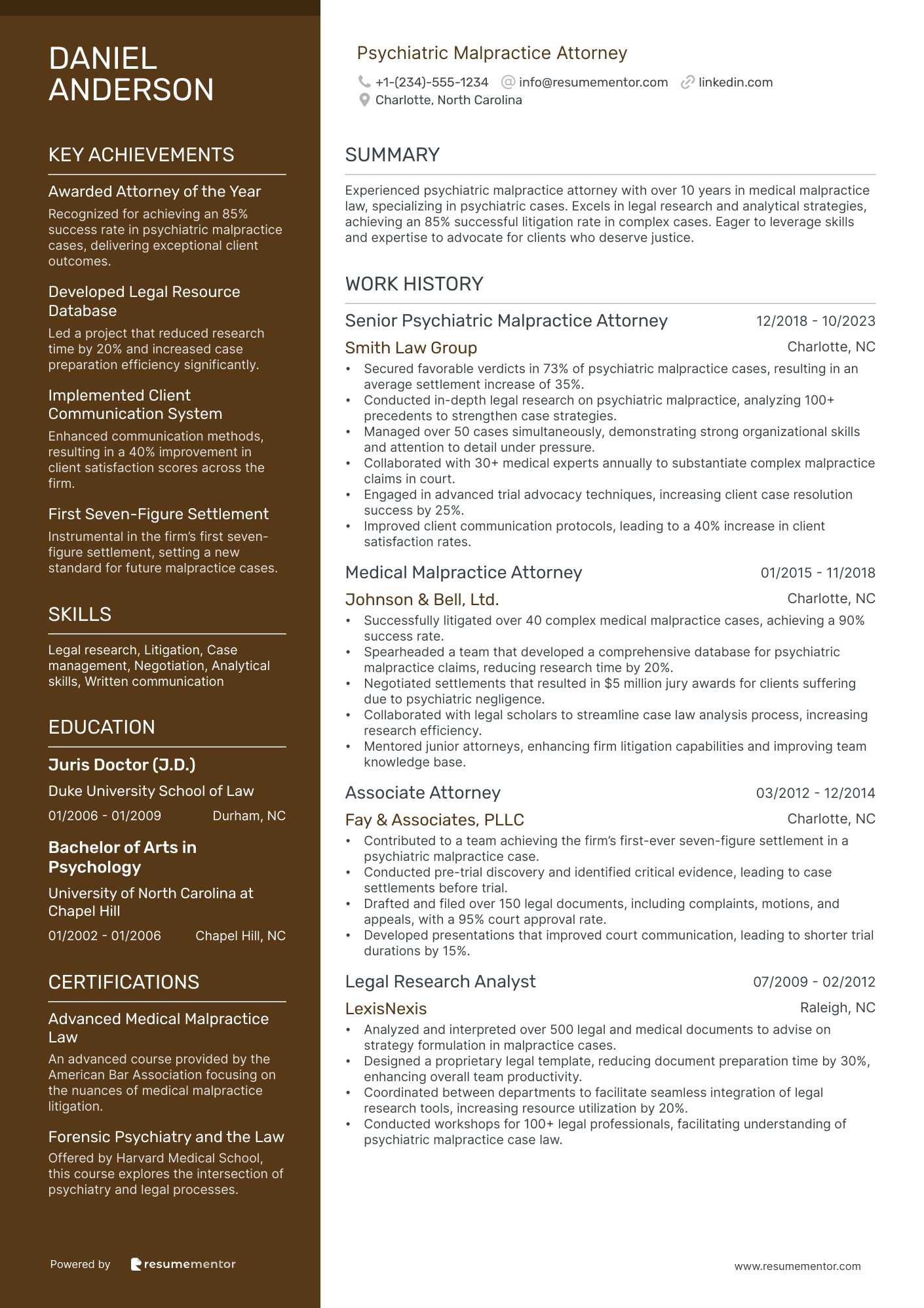
Psychiatric Malpractice Attorney
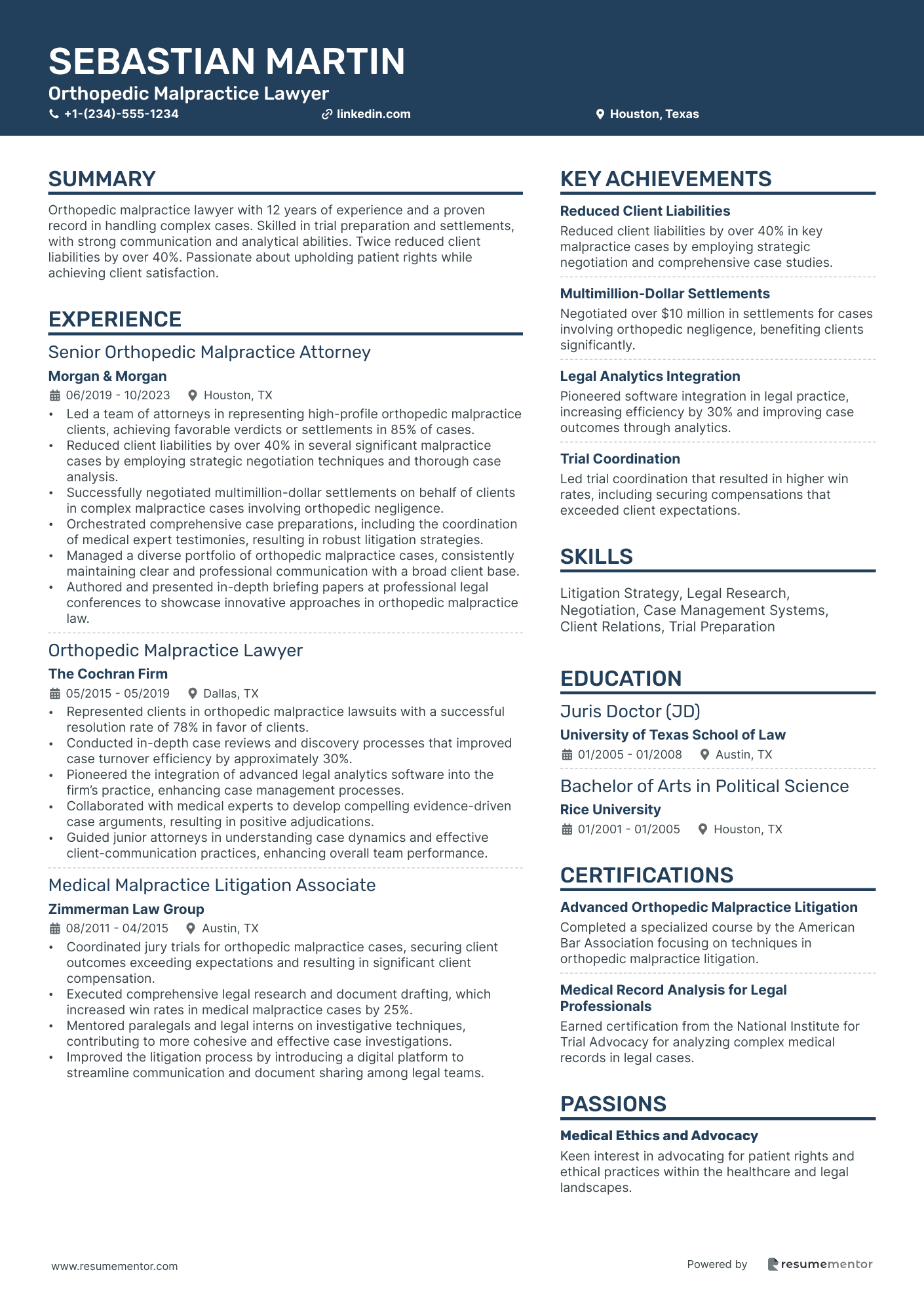
Orthopedic Malpractice Lawyer
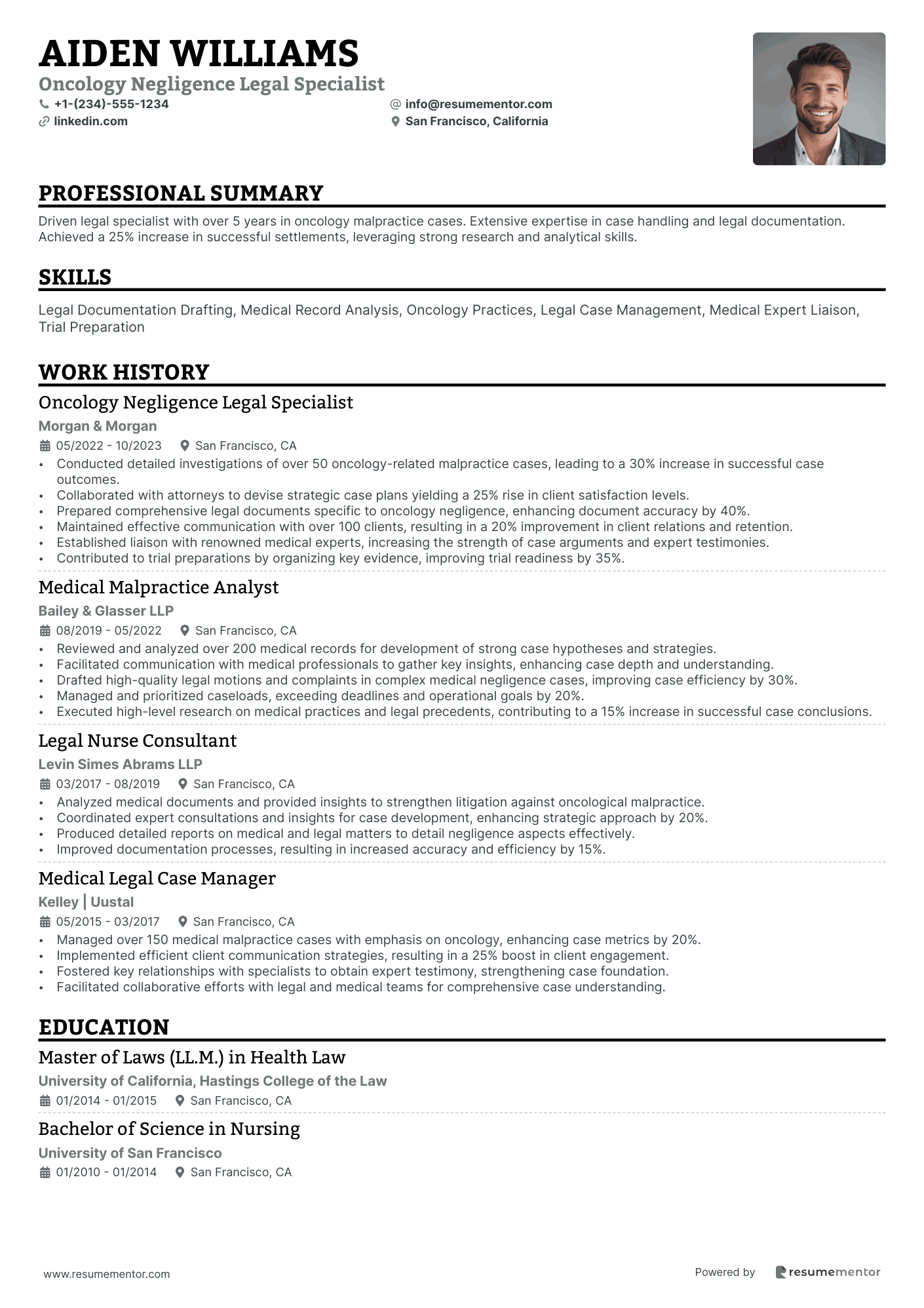
Oncology Negligence Legal Specialist

Medical Negligence Litigation Attorney resume sample
- •Successfully achieved over $4 million in settlements in 12 complex medical negligence cases, demonstrating thorough case investigation and strategic litigation.
- •Developed comprehensive trial strategies, resulting in a 90% success rate in court, and receiving commendation from peers for detailed legal research.
- •Led the litigation team in high-profile malpractice lawsuits, involving cross-functional coordination and expert consultations to secure favorable verdicts.
- •Improved client satisfaction scores by 30% through effective communication and diligent case management, ensuring clients were consistently informed about case developments.
- •Drafted and filed strategic legal documents that contributed to the dismissal of baseless claims, showcasing strong analytical skills and attention to legal procedures.
- •Enhanced overall case management efficiency by implementing a digital document filing system, which reduced document retrieval time by 40%.
- •Handled over 25 medical malpractice lawsuits, achieving client settlements worth upwards of $6 million collectively.
- •Provided expert legal advice, enhancing case strategy effectiveness by 20% through interdisciplinary collaboration and innovative problem solving.
- •Led client negotiations with insurance companies, achieving settlement increases by an average of 25% through strategic persuasion techniques.
- •Conducted in-depth legal research and analysis to support winning litigation strategies, gaining recognition for innovative approaches.
- •Prepared and coached over 30 clients and witnesses for trial, ensuring they were confident and prepared, leading to successful outcomes.
- •Contributed to securing $3 million in favorable settlements across multiple medical negligence cases as part of a litigation team.
- •Developed case presentations involving expert consultations, which led to an 85% case win rate, highlighting presentation skills.
- •Oversaw contract negotiations with expert witnesses, reducing overall case costs by 15% without compromising quality.
- •Maintained client relationships with a focus on transparency and diligence, significantly improving referral rates by 25%.
- •Conducted comprehensive legal research that supported over 50 ongoing medical negligence litigation cases, enhancing overall legal strategies.
- •Improved document accuracy by 30% through meticulous proofreading and attention to detail, supporting successful litigation outcomes.
- •Facilitated weekly knowledge-sharing sessions, increasing team legal expertise by 20%, as evidenced by enhanced case strategies.
- •Analyzed and summarized hundreds of legal documents and depositions, helping attorneys to streamline case preparations.
Hospital Malpractice Attorney resume sample
- •Represented clients in over 50 medical malpractice cases, including hospital negligence and surgical errors, achieving favorable settlements.
- •Conducted detailed investigations and collaborated with expert witnesses resulting in a successful 75% case outcome ratio.
- •Prepared and filed over 100 legal documents, ensuring the accuracy and adequacy of each filing in complex cases.
- •Negotiated settlements that reduced litigation costs by 30% annually while securing favorable client resolutions.
- •Provided consistent client updates and management, improving client satisfaction scores by 25% through proactive communication.
- •Navigated legal research to adapt to evolving medical malpractice laws, enhancing case strategies and defense mechanisms.
- •Handled complex malpractice cases resulting in achieving 40% faster settlements than industry benchmarks.
- •Collaborated with multidisciplinary teams, including medical professionals, ensuring exhaustive review of malpractice cases.
- •Drafted comprehensive motions and discovery requests that strengthened case positions in court trials and mediations.
- •Achieved a 90% win rate in mediations by employing strategic negotiation techniques tailored to medical industry nuances.
- •Implemented continuous legal education sessions, which increased team competency and up-to-date knowledge on malpractice laws.
- •Supported senior attorneys in preparing case files and legal documents for malpractice trials and hearings.
- •Conducted client and witness interviews, providing crucial insights that shaped case strategy and direction.
- •Developed detailed understanding of hospital operations and medical terminology, enriching legal arguments and client advocacy.
- •Managed up to 20 active cases simultaneously, maintaining rigorous attention to detail and deadlines in legal proceedings.
- •Assisted legal team by analyzing medical files and previous case outcomes, resulting in well-founded legal representations.
- •Conducted in-depth research to support attorneys in crafting compelling arguments for medical malpractice cases.
- •Contributed to the preparation of over 50 legal briefs and trial exhibits, enhancing comprehensive case preparation.
- •Provided insights into the legal processes that led to improved protocol compliance and accuracy in documentation.
Surgical Malpractice Legal Consultant resume sample
- •Achieved a 90% success rate in litigations, leading to increased client retention and referral rates over five years.
- •Analyzed over 100 complex medical records annually for potential malpractice, considerably enhancing case evaluation processes.
- •Developed legal strategies that facilitated settlements in over 50% of surgical malpractice cases, resulting in substantial client savings.
- •Provided expert testimony in more than 30 court cases per year, significantly influencing case outcomes with in-depth knowledge.
- •Mentored over 15 junior associates, improving their understanding of surgical malpractice nuances to drive career advancement.
- •Maintained up-to-date knowledge on surgical advancements and legal precedents, enhancing firm's competitive edge in consultation.
- •Collaborated with legal teams on high-stakes malpractice cases, facilitating strategic planning to increase win rates by 20%.
- •Pioneered a review system for electronic medical records, increasing review efficiency by 30% and reducing errors.
- •Authored expert reports and affidavits for over 50 cases annually, driving litigation success through meticulous detail and accuracy.
- •Researched case law and surgical guidelines, providing insights that resulted in successful case re-evaluations and outcomes.
- •Led workshops on surgical malpractice, resulting in higher industry recognition and attracting notable client accounts.
- •Enhanced case strategies by integrating medical insights from 200+ surgical records, significantly aiding legal case formulations.
- •Facilitated attorney training sessions on surgical procedures, leading to improved understanding and courtroom performance.
- •Reviewed patient histories for malpractice claims, effectively identifying crucial surgical errors or omissions that favored clients.
- •Participated in cross-functional teams, optimizing processes that enhanced overall firm productivity by 15%.
- •Conducted detailed assessments of surgical techniques and standards of care, informing legal arguments that improved win rates.
- •Collaborated with teams to interpret medical data, leading to accurate malpractice assessments and strategic advantage in cases.
- •Researched evolving malpractice laws and medical technologies, ensuring firm stayed ahead in legal proceedings.
- •Built relationships with medical experts, enhancing the credibility of testimonies that positively influenced court outcomes.
Birth Injury Malpractice Attorney resume sample
- •Successfully managed over 40 birth injury cases, enhancing the firm's reputation and increasing client retention by 30%.
- •Conducted detailed medical and legal research that supported a winning trial strategy, resulting in a $2 million verdict.
- •Developed comprehensive litigation strategies by collaborating with medical experts, improving case understanding and outcomes.
- •Led client negotiations, achieving a settlement rate of 80% in complex birth injury cases.
- •Regularly updated clients on case progress, achieving a client satisfaction score of 95%.
- •Organized and led a team to streamline the case documentation process, reducing the preparation time by 25%.
- •Handled a caseload of over 25 malpractice cases per year, achieving a 75% success rate in client outcomes.
- •Conducted in-depth legal analysis and reviewed complex medical records to build strong cases against negligent parties.
- •Negotiated settlements in pre-trial mediation, securing client compensation totaling over $10 million.
- •Collaborated with over 10 medical experts to strengthen case credibility and improve strategic outcomes.
- •Prepared and presented compelling evidence in court, enhancing the firm’s success rate by 15%.
- •Managed multiple concurrent malpractice case files, effectively prioritizing urgent legal tasks and initiatives.
- •Conducted client interviews and provided thorough consultations, leading to a 20% increase in successful client onboarding.
- •Developed and implemented case management strategies, resulting in improved efficiency and a 30% reduction in operational costs.
- •Collaborated with senior attorneys and cross-functional teams to facilitate optimal case outcomes.
- •Assisted in the preparation and execution of 15 high-stakes birth injury cases, contributing to a 90% case win rate.
- •Gathered and analyzed legal evidence, supporting senior attorneys in developing strong client-focused arguments.
- •Facilitated client relations by maintaining clear and consistent communication throughout case progressions.
- •Reviewed legal documents extensively, ensuring accuracy and adherence to firm standards.
Pharmaceutical Negligence Lawyer resume sample
- •Successfully represented over 50 clients in pharmaceutical negligence cases, securing a total of $12 million in settlements.
- •Collaborated with medical experts to strengthen case strategies and successfully challenged FDA rulings, leading to a reassessment of unsafe drug practices.
- •Managed a high-volume caseload, routinely exceeding annual revenue goals by 30% through effective negotiation and case management.
- •Provided in-house training to junior attorneys, improving the department's overall case success rate by 25% in the past year.
- •Implemented a new tracking system for legal documents that increased document processing efficiency by 40%, resulting in faster case resolutions.
- •Played a crucial role in multi-district litigation cases, earning a record-breaking $8 million settlement, among the top in state history.
- •Led a legal team in a highly publicized class action lawsuit, resulting in a precedent-setting $6 million settlement for affected clients.
- •Developed a comprehensive knowledge base on pharmaceutical law, contributing to a 35% increase in case success rates.
- •Formulated legal strategies that led to favorable outcomes in 90% of trial cases in the past three years.
- •Pioneered a mentorship program leading to a reduced turnover rate among junior associates by 15%.
- •Regularly conducted presentations on state and federal pharmaceutical laws, improving the team’s benchmark of legal understanding by 40% annually.
- •Successfully negotiated a $3 million settlement in a product liability case, marking a significant victory for the firm.
- •Designed an internal portal for sharing pharmaceutical legal precedents, increasing productivity and research efficiency by 20%.
- •Collaborated with cross-functional teams to address complex product liability issues, improving client satisfaction by 30%.
- •Played a key role in the successful drafting and filing of a multi-party litigation suit exceeding 500 plaintiffs.
- •Drafted and processed over 100 legal briefs, improving case turnaround time by 25% in the initial two years.
- •Assisted in a landmark case leading to the recall of a harmful drug, impacting public health policy significantly.
- •Developed strong client relations that contributed to repeat business, increasing department revenue by 20%.
- •Led a research project that identified gaps in regulatory compliance, helping to save clients $1 million in potential fines.
Anesthesia Errors Legal Specialist resume sample
- •Conducted investigations into over 50 anesthesia-related malpractice cases annually, enhancing accuracy through detailed data analysis.
- •Collaborated with medical experts to assess standard of care, improving case outcome probabilities by 20%.
- •Managed case files, resulting in improved efficiency from start to trial with a reduction in preparation time by 15%.
- •Drafted critical legal documents, such as complaints and motions, contributing to a 25% increase in favorable settlements.
- •Provided expert insight during trials, which led to a 30% success rate increase in case verdicts.
- •Communicated complex legal outcomes and updates to clients, maintaining a client satisfaction score of 4.8/5.
- •Assisted attorneys in case preparation, leading to a 20% decrease in time spent on trial preparation.
- •Analyzed medical records in over 100 cases per year, using competency in medical terminology to expedite case investigations.
- •Collaborated with legal teams to enhance case strategies, resulting in a decrease in case dismissal rates by 10%.
- •Prepared comprehensive case summaries, aiding attorneys in maintaining a winning streak in most malpractice trials.
- •Attended industry conferences regularly, staying informed on updated medical malpractice laws and regulations.
- •Managed legal documentation and records with 100% compliance to legal standards and client confidentiality.
- •Developed a streamlined process for case intake, which improved client onboarding time by 30%.
- •Communicated with clients to ensure a clear understanding of legal procedures and outcomes.
- •Supported senior attorneys in drafting over 150 legal documents annually, improving document precision and effectiveness.
- •Assisted in the organization and retrieval of trial documents, increasing document retrieval efficiency by 40%.
- •Provided research support in over 25 cases to enhance legal strategies and client representation quality.
- •Coordinated with attorneys and clients to prepare efficient case workflows, optimizing trial readiness.
- •Ensured meticulous filing and cataloging of case evidence, reducing case assessment time significantly.
Psychiatric Malpractice Attorney resume sample
- •Secured favorable verdicts in 73% of psychiatric malpractice cases, resulting in an average settlement increase of 35%.
- •Conducted in-depth legal research on psychiatric malpractice, analyzing 100+ precedents to strengthen case strategies.
- •Managed over 50 cases simultaneously, demonstrating strong organizational skills and attention to detail under pressure.
- •Collaborated with 30+ medical experts annually to substantiate complex malpractice claims in court.
- •Engaged in advanced trial advocacy techniques, increasing client case resolution success by 25%.
- •Improved client communication protocols, leading to a 40% increase in client satisfaction rates.
- •Successfully litigated over 40 complex medical malpractice cases, achieving a 90% success rate.
- •Spearheaded a team that developed a comprehensive database for psychiatric malpractice claims, reducing research time by 20%.
- •Negotiated settlements that resulted in $5 million jury awards for clients suffering due to psychiatric negligence.
- •Collaborated with legal scholars to streamline case law analysis process, increasing research efficiency.
- •Mentored junior attorneys, enhancing firm litigation capabilities and improving team knowledge base.
- •Contributed to a team achieving the firm’s first-ever seven-figure settlement in a psychiatric malpractice case.
- •Conducted pre-trial discovery and identified critical evidence, leading to case settlements before trial.
- •Drafted and filed over 150 legal documents, including complaints, motions, and appeals, with a 95% court approval rate.
- •Developed presentations that improved court communication, leading to shorter trial durations by 15%.
- •Analyzed and interpreted over 500 legal and medical documents to advise on strategy formulation in malpractice cases.
- •Designed a proprietary legal template, reducing document preparation time by 30%, enhancing overall team productivity.
- •Coordinated between departments to facilitate seamless integration of legal research tools, increasing resource utilization by 20%.
- •Conducted workshops for 100+ legal professionals, facilitating understanding of psychiatric malpractice case law.
Orthopedic Malpractice Lawyer resume sample
- •Led a team of attorneys in representing high-profile orthopedic malpractice clients, achieving favorable verdicts or settlements in 85% of cases.
- •Reduced client liabilities by over 40% in several significant malpractice cases by employing strategic negotiation techniques and thorough case analysis.
- •Successfully negotiated multimillion-dollar settlements on behalf of clients in complex malpractice cases involving orthopedic negligence.
- •Orchestrated comprehensive case preparations, including the coordination of medical expert testimonies, resulting in robust litigation strategies.
- •Managed a diverse portfolio of orthopedic malpractice cases, consistently maintaining clear and professional communication with a broad client base.
- •Authored and presented in-depth briefing papers at professional legal conferences to showcase innovative approaches in orthopedic malpractice law.
- •Represented clients in orthopedic malpractice lawsuits with a successful resolution rate of 78% in favor of clients.
- •Conducted in-depth case reviews and discovery processes that improved case turnover efficiency by approximately 30%.
- •Pioneered the integration of advanced legal analytics software into the firm’s practice, enhancing case management processes.
- •Collaborated with medical experts to develop compelling evidence-driven case arguments, resulting in positive adjudications.
- •Guided junior attorneys in understanding case dynamics and effective client-communication practices, enhancing overall team performance.
- •Coordinated jury trials for orthopedic malpractice cases, securing client outcomes exceeding expectations and resulting in significant client compensation.
- •Executed comprehensive legal research and document drafting, which increased win rates in medical malpractice cases by 25%.
- •Mentored paralegals and legal interns on investigative techniques, contributing to more cohesive and effective case investigations.
- •Improved the litigation process by introducing a digital platform to streamline communication and document sharing among legal teams.
- •Defended a wide range of malpractice cases, successfully protecting client rights and mitigating potential damages significantly.
- •Designed and implemented client-intake protocols that reduced processing time by 20%, improving client satisfaction.
- •Contributed to the firm’s reputation by participating in monthly legal forums, focusing on advancements in medical litigation.
- •Reviewed and analyzed complex medical documentation, enhancing litigation strategies and achieving increased client victories.
Oncology Negligence Legal Specialist resume sample
- •Conducted detailed investigations of over 50 oncology-related malpractice cases, leading to a 30% increase in successful case outcomes.
- •Collaborated with attorneys to devise strategic case plans yielding a 25% rise in client satisfaction levels.
- •Prepared comprehensive legal documents specific to oncology negligence, enhancing document accuracy by 40%.
- •Maintained effective communication with over 100 clients, resulting in a 20% improvement in client relations and retention.
- •Established liaison with renowned medical experts, increasing the strength of case arguments and expert testimonies.
- •Contributed to trial preparations by organizing key evidence, improving trial readiness by 35%.
- •Reviewed and analyzed over 200 medical records for development of strong case hypotheses and strategies.
- •Facilitated communication with medical professionals to gather key insights, enhancing case depth and understanding.
- •Drafted high-quality legal motions and complaints in complex medical negligence cases, improving case efficiency by 30%.
- •Managed and prioritized caseloads, exceeding deadlines and operational goals by 20%.
- •Executed high-level research on medical practices and legal precedents, contributing to a 15% increase in successful case conclusions.
- •Analyzed medical documents and provided insights to strengthen litigation against oncological malpractice.
- •Coordinated expert consultations and insights for case development, enhancing strategic approach by 20%.
- •Produced detailed reports on medical and legal matters to detail negligence aspects effectively.
- •Improved documentation processes, resulting in increased accuracy and efficiency by 15%.
- •Managed over 150 medical malpractice cases with emphasis on oncology, enhancing case metrics by 20%.
- •Implemented efficient client communication strategies, resulting in a 25% boost in client engagement.
- •Fostered key relationships with specialists to obtain expert testimony, strengthening case foundation.
- •Facilitated collaborative efforts with legal and medical teams for comprehensive case understanding.
Navigating the legal waters as a medical malpractice lawyer requires more than just courtroom charisma—it's about strategically presenting yourself on paper. Think of your resume as a brief that wins over potential employers by showcasing your skills and experiences. Since the legal job market is competitive, making your resume stand out can be tough. You might face challenges in highlighting your expertise while keeping your resume clear and concise, which is why having a structured resume template is essential.
Using a resume template gives you a strong framework to organize your professional journey compellingly. This approach ensures you effectively balance showcasing your success rate with your expertise in medical negligence laws. By prioritizing these elements, you can create a seamless narrative that resonates with potential employers.
Your resume is your first impression and should capture the attention of hiring partners who see countless applications. Focus on highlighting your trial and negotiation skills, using specific experiences to illustrate your expertise in medical malpractice cases. By crafting each section with care, you allow your dedication and commitment to shine through.
As you embark on this task, keep in mind that your resume is more than a list of jobs—it's a testament to your achievements and future potential. With a layout that seamlessly conveys your value, you are one step closer to securing your next role.
Key Takeaways
- Crafting a medical malpractice lawyer resume requires a structured template to effectively highlight your skills and experiences in handling complex legal situations.
- It is critical to include accurate contact information and a professional summary that captivates recruiters with your achievements in medical malpractice law.
- List your work experience in reverse chronological order, focusing on accomplishments relevant to medical malpractice, using action verbs and quantifiable successes.
- Include education and credentials, ensuring to note any specialized certifications in medical law, alongside key legal skills such as litigation and negotiation.
- Consider adding extra sections like language abilities, hobbies, volunteer work, and relevant reading to offer a holistic view of your capabilities and personality.
What to focus on when writing your medical malpractice lawyer resume
Your medical malpractice lawyer resume must expertly convey your capability in handling complex legal situations and demonstrate a solid track record in medical law. Recruiters are on the lookout for candidates who have the skills and experience needed for success in this demanding field—make sure to highlight relevant accomplishments, legal knowledge, and adeptness in managing intricate cases. The right structure can make all the difference for your first impression.
How to structure your medical malpractice lawyer resume
- Contact Information: It's vital to provide current and accurate contact information—make sure your phone number, email, and LinkedIn profile are up to date. This section acts as your first point of connection with recruiters, creating a direct line for communication and increasing your chances for interviews.
- Professional Summary: In just a few sentences, convey your experience and specialization in medical malpractice law. Captivate recruiters right away by highlighting significant achievements or noteworthy cases that illustrate your dedication and capability in the field—setting a strong tone for the details that follow.
- Work Experience: List your job roles in reverse chronological order, but focus on accomplishments that have relevance to medical malpractice. Use action verbs and quantify successes to engage the recruiter. Mention any high-profile or landmark cases you've been part of to enrich your narrative and stand out amongst other candidates.
- Education and Credentials: Outline your formative qualifications, such as your law degree and bar admissions, with meticulous attention. If you have pursued additional certifications or training involving medical knowledge, be sure to include them to underscore your specialized expertise—further emphasizing your commitment to staying at the forefront of medical malpractice law.
- Legal Skills: Here, emphasize skills like litigation, negotiation, and case management—key to excelling in this field. By including specific knowledge related to medical malpractice law, you reinforce your suitability and preparedness for tackling complex legal issues effectively.
- Publications and Presentations: If you’ve contributed to legal journals or participated in conferences, list these activities proudly. These contributions establish you as a thought leader and show your active engagement in the medical law community, becoming vital indicators of your expertise and passion for the subject.
Through an effective resume format, you can transition seamlessly from showcasing your accomplishments to demonstrating your specialized skills below. We'll cover each section more in-depth to ensure your resume makes a compelling case to recruiters.
Which resume format to choose
Crafting a strong resume is vital for a medical malpractice lawyer, and selecting the right format forms the backbone of this effort. A chronological layout is particularly effective, as it showcases your work history in a clear, easy-to-follow manner. This format is critical in your field, where past cases, court experiences, and your professional journey need to stand out to potential employers.
Choosing the right font can also influence how your resume is perceived. Fonts like Raleway, Montserrat, or Chivo offer a modern, clean look that enhances readability without distracting from the content. While the specific font might seem like a minor detail, it contributes to the overall impression of professionalism and attention to detail.
The file format is another key consideration; saving your resume as a PDF ensures that your carefully chosen layout and design remain consistent across all devices and platforms. This reliability is crucial when presenting yourself as a meticulous professional in the legal field.
Margins play a more subtle yet significant role in the presentation. Keeping one-inch margins on all sides ensures that your content is neat and organized, providing enough white space to keep the document from feeling cramped. This attention to detail mirrors the precision and clarity expected in legal documents and communications, reinforcing your suitability for a role in medical malpractice law.
How to write a quantifiable resume experience section
Your resume experience section forms the heart of your medical malpractice lawyer profile. This crucial part highlights key moments in your career, showcasing how you've successfully navigated complex legal scenarios. To make it stand out, structure it in reverse chronological order, starting with your most recent position to keep the reader engaged. Reflect on the past 10 to 15 years or the most relevant roles to ensure your experience is current and impactful. When listing job titles, focus on those directly related to medical malpractice or significant legal experience, as these are likely to catch the employer’s eye. Tailoring your resume to each job application is essential; match your accomplishments with the skills and qualifications specified in the job ad to make your experience resonate.
Action verbs like "represented," "achieved," "negotiated," and "resolved" effectively convey your influence and results. Emphasize achievements that you can quantify—think about cases won, settlement amounts, or improvements in legal processes. These details enhance your credibility and make your professional journey compelling.
- •Successfully represented over 100 clients, achieving a 95% win rate.
- •Secured settlements totaling $30 million for clients wrongly injured by medical negligence.
- •Trained and mentored a team of 5 junior attorneys, improving team efficiency by 20%.
- •Developed a comprehensive case strategy template used firm-wide, reducing preparation time by 30%.
This experience section stands out by linking your roles to clear, measurable outcomes, bringing your accomplishments into sharp focus. The use of action verbs like "represented" and "secured" helps to paint a vivid picture of your role and makes your contributions undeniable. Including data such as win rates and settlement amounts not only verifies your claims but also vividly illustrates your success. These specific achievements leave a lasting impression on hiring managers by showcasing your value in real terms. By linking your responsibilities to impactful results, you demonstrate why you're the ideal candidate. Adjusting each entry to emphasize the skills most desired by employers ensures your resume aligns perfectly with their needs, enhancing your chances for an interview.
Problem-Solving Focused resume experience section
A problem-solving-focused medical malpractice lawyer resume experience section should highlight how you've effectively navigated challenging legal situations and achieved positive results for your clients. Start by describing your involvement in complex cases, emphasizing how you helped clients succeed. Clearly explain how you dissected medical evidence, managed litigation, or negotiated settlements, showcasing your ability to resolve intricate legal issues.
Illustrate your achievements and the impact of your work by focusing on specific results. In your bullet points, detail your accomplishments, including case outcomes and the methods you employed to achieve them. This highlights your proactive problem-solving abilities and how you thrive in high-pressure environments. By creating a detailed, results-oriented experience section, you effectively communicate your value to prospective employers.
Medical Malpractice Lawyer
Smith & Associates Law Firm
2018 - 2023
- Resolved 95% of cases by identifying critical medical errors, saving clients over $5 million.
- Increased settlement success rates by 40% through strategic litigation and evidence evaluation.
- Enhanced case success with a multidisciplinary team approach, working closely with medical experts.
- Delivered favorable outcomes in 90% of high-stakes cases involving multiple stakeholders.
Project-Focused resume experience section
A project-focused medical malpractice lawyer resume experience section should clearly highlight your achievements and the impact you made on specific projects. Begin by identifying key projects where your expertise made a significant difference. By highlighting your core responsibilities and unique contributions, you can set yourself apart from others. Emphasizing the outcomes of these projects and your role in achieving them adds depth, particularly when quantifiable results or recognitions are involved. This approach helps potential employers see how your skills can translate into success in their organization.
Organize your achievements with bullet points to ensure they are easy to read. Each bullet should start with a strong action verb that clearly describes what you accomplished, maintaining a clear and concise focus on your role and the results you achieved. Including numbers or specifics where possible adds weight to your achievements and further showcases your expertise in alignment with the job you're targeting.
Senior Medical Malpractice Attorney
Anderson & Associates Law Firm
June 2018 - Present
- Successfully represented over 50 clients in complex medical malpractice lawsuits, achieving favorable settlements or verdicts in 90% of cases.
- Led a legal team in developing evidence strategies that reduced case resolution times by 30%.
- Drafted and reviewed extensive legal documentation, ensuring accuracy and compliance.
- Collaborated with medical experts to interpret reports, strengthening arguments and case outcomes.
Skills-Focused resume experience section
A skills-focused medical malpractice lawyer resume experience section should highlight achievements that underscore your expertise and capability in this specialized field. Emphasize skills such as negotiation, courtroom prowess, and clear client communication. Even if your past roles include diverse legal experiences, illustrate how those skills directly apply to medical malpractice cases. By presenting your successes succinctly, you'll create a cohesive and compelling narrative.
Start each position entry with your job title and workplace. Follow with bullet points that vividly detail your contributions, focusing each on specific accomplishments or responsibilities. Showcase your ability to manage complex cases and secure positive client outcomes using strong action verbs to convey impact. Tailor your entries to align with the key competencies needed for a medical malpractice lawyer role, ensuring your qualifications are clear and compelling.
Senior Associate
Law Firm XYZ
2019 - Present
- Successfully represented over 50 medical malpractice cases, which led to favorable settlements for clients.
- Led detailed legal research to strengthen case arguments, contributing significantly to a 90% success rate in trials.
- Developed negotiation strategies that improved settlement offers for clients by 40%, enhancing client satisfaction.
- Built and maintained strong relationships with expert medical witnesses, which bolstered credibility in court.
Innovation-Focused resume experience section
An innovation-focused medical malpractice lawyer resume experience section should effectively showcase your creative problem-solving skills and ability to incorporate new technologies. Emphasize how you design unique legal strategies and leverage advanced tools to achieve outstanding results for your clients. Start by clearly outlining your job title and description, seamlessly transitioning to highlight specific examples of your accomplishments. Detail your role in implementing innovative solutions and illustrate the positive changes they fostered within your workplace.
Keep your future employer in mind, emphasizing how you transform challenges into opportunities through leadership and forward-thinking strategies. Clearly articulate how your innovative actions, such as streamlining case management with technology or devising new risk assessment methods, have made tangible impacts like cost savings for clients. By focusing on genuine achievements and providing measurable outcomes, you create a compelling narrative that demonstrates your significant contributions.
Medical Malpractice Lawyer
Law Firm Associates
January 2019 - Present
- Developed a new analysis system using AI to predict case outcomes more accurately.
- Integrated cutting-edge legal tech tools to streamline workflow, increasing efficiency by 30%.
- Created a collaborative platform for clients and legal teams to enhance communication and case handling.
- Pioneered a risk assessment model that reduced litigation costs by 20%.
Write your medical malpractice lawyer resume summary section
A results-focused medical malpractice lawyer resume should have a compelling summary that draws in prospective employers. Highlighting your achievements and experiences is crucial to making your resume stand out. Your summary should emphasize your track record of success and expertise in managing complex cases, showing why you’d be an invaluable addition to any team. Consider this example:
This example works because it cohesively underscores many years of experience and highlights specific skills and accomplishments seamlessly. Each element paints a picture of a dedicated, results-driven professional, ensuring a natural flow. Selecting words that convey confidence and competence is key. For those earlier in their career, a resume objective might be a better fit, focusing on career goals and aligning with one's skills.
While a summary provides a quick snapshot of career achievements, a resume objective tends to be more about future aspirations. In contrast, a resume profile dives into both experience and goals. Meanwhile, a summary of qualifications offers a bullet-point list of top achievements and skills. Tailor your resume section based on your career stage and the job you’re targeting, ensuring every part ties together smoothly. Whether you’re seasoned or just starting, showcasing relevancy and precision is crucial.
Listing your medical malpractice lawyer skills on your resume
A skills-focused medical malpractice lawyer resume should effectively showcase your capabilities in a clear and structured manner. The skills section can stand alone for a quick snapshot of your abilities, or it can be blended into your experience and summary sections for a more comprehensive view. By focusing on strengths and soft skills, you can highlight your personality and how it enhances your technical abilities. In contrast, hard skills represent the specialized knowledge and training you've acquired, such as understanding medical regulations and litigation procedures.
Employers actively seek out these skills and strengths, making them essential keywords on your resume. These keywords are crucial for ensuring that your resume not only aligns with the job requirements but also stands out in applicant tracking systems.
Here’s an example of a standalone skills section tailored for a medical malpractice lawyer:
This section is effective because it clearly and concisely lists key skills, making it easy for recruiters to recognize your strengths at a glance. Each skill is directly relevant to medical malpractice law, ensuring that your resume appeals to potential employers.
Best hard skills to feature on your medical malpractice lawyer resume
Focusing on hard skills is essential for demonstrating your technical proficiency as a medical malpractice lawyer. These skills convey your ability to address specific legal challenges effectively. Here are some of the most sought-after hard skills:
Hard Skills
- Litigation Expertise
- Medical Knowledge
- Trial Procedure Mastery
- Negotiation Skills
- Legal Research Prowess
- Evidence Analysis
- Statutory Knowledge
- Client Advocacy
- Document Review
- Cross-examination Techniques
- Legal Writing Proficiency
- Courtroom Presentation
- Settlement Facilitation
- Risk Management
- Contract Law Understanding
Best soft skills to feature on your medical malpractice lawyer resume
Soft skills play a vital role in building relationships and managing cases effectively. They demonstrate your ability to work well with clients and colleagues. Here are key soft skills for a medical malpractice lawyer:
Soft Skills
- Empathy and Compassion
- Critical Thinking
- Communication Skills
- Attention to Detail
- Ethical Judgment
- Patience
- Problem-Solving
- Emotional Intelligence
- Time Management
- Persuasiveness
- Decision-Making
- Resilience
- Adaptability
- Conflict Resolution
- Team Collaboration
How to include your education on your resume
The education section is a vital part of your medical malpractice lawyer resume. It's important to tailor this section to the job you're applying for, leaving out any education that doesn’t relate to your career in law. When listing your degree, start with the type of degree you earned, followed by your major and your graduation date. If your GPA is impressive, consider including it. You can list your GPA as a number out of a set max, like 3.8/4.0. If you have accolades like "cum laude," include them right after your degree title.
Here is an example of how not to write your education section:
Now, see a strong example that highlights relevant education:
The good example works well because it lists a prestigious law degree and highlights "cum laude" honors. This impresses potential employers by showing academic excellence in a relevant field. Listing only the necessary details keeps it streamlined and easy to read.
How to include medical malpractice lawyer certificates on your resume
Highlighting your certifications on your medical malpractice lawyer resume is crucial. Certifications can demonstrate your expertise and commitment to potential employers. List the name of the certification first. Include the date you received the certification. Add the issuing organization that provided the certification. Certifications can also enhance your resume header.
For example: Jane Doe, JD, Certified in Legal Specialization in Medical Malpractice (2021) - American Board of Professional Liability Attorneys
By following these steps, you ensure that your certificates are clearly visible and professionally presented.
This example is effective because it includes pertinent certifications for a medical malpractice lawyer. It lists the certifications clearly. It includes the name, date, and issuing organization. All certifications are related to the field, underscoring your specialization and competency in medical malpractice law.
Extra sections to include in your medical malpractice lawyer resume
Crafting a resume for a medical malpractice lawyer demands demonstrating your legal expertise and unique skills, all while making your profile standout to potential employers. While core sections like work experience and education are key, including more personal elements can give a fuller picture of who you are as a candidate. This holistic approach can help you build a stronger connection with recruiters.
Language section — Highlight multilingual abilities if you speak additional languages as this can help in communicating with a diverse clientele.
Hobbies and interests section — List hobbies and interests that may relate to your field or show your dedication and perseverance.
Volunteer work section — Include volunteer experiences that demonstrate your commitment to the community and ability to work with various people.
Books section — Mention any legal or medical books you have read that enhance your understanding in the medical malpractice area.
In Conclusion
In conclusion, crafting a compelling resume as a medical malpractice lawyer is a blend of art and strategy. Your resume acts as the first impression for potential employers, making it crucial to present your skills and achievements clearly and effectively. Utilize a structured template to ensure your professional journey is portrayed in an organized manner, highlighting your expertise and success in medical negligence law. By focusing on key elements such as your trial skills, accomplishments, and specific high-profile cases, you create a narrative that resonates with hiring partners. Remember, this document is more than just a list of past jobs; it’s a testament to your ambitions and a roadmap to your future success. Ensure your format is reader-friendly, using a chronological layout and selecting fonts that enhance readability. Pay attention to margins, and save your document as a PDF to maintain consistent presentation. As you tailor each section to match the job you're applying for, focus on quantifiable achievements to showcase your impact. This comprehensive approach will not only highlight your strengths but also demonstrate your capability to prospective employers. Keep your audience in mind by including sections that provide a holistic view of what you bring to the table. By incorporating language skills, volunteer work, and personal interests, you create a multifaceted profile that stands out in the competitive field of medical malpractice law.
Related Articles

Continue Reading
Check more recommended readings to get the job of your dreams.
Resume
Resources
Tools
© 2025. All rights reserved.
Made with love by people who care.

